A Patent on Problems

Illustration by John S. Dykes
When David Kappos was sworn in as director of the U.S. Patent and Trademark Office in August, he must have felt like a pilot brought in midflight to take the controls of an airplane in a tailspin. He said as much not long after.
“The nose of this airplane is pointed down,” he bluntly told a gathering of corporate counsel.
As goes the patent office, so goes the economy, says Kappos, who came to the job from IBM, where he was vice president and assistant general counsel. The PTO either launches or buries innovation, the watchword in a nation whose manufacturing muscle has withered.
And it is widely believed the PTO has become a burial ground for potential. Stakeholders have been howling about the agency’s huge and growing backlog. They find applying for a patent to be somewhat like buying a lottery ticket. From universities counting on income from gains in research to independent inventors, from the electronic and high-tech industries to big pharma and biotech, they complain about losing what might have been.
“That is very, very unfortunate because literally every one of those is a potential breakthrough innovation not being put into the marketplace, not creating jobs, not creating economic advantage for our country,” Kappos says.
Of the agency’s backlog of 1.2 million patent applications, 770,000 have yet to see the initial light of an examiner’s computer screen. The total nearly doubled from 1990 to 2000. Since then the backlog has increased by a factor of 2.5.
Meanwhile, the percentage of patents issued, known as the allowance rate, was steady for decades at about 65 percent or more. It ran up to more than 70 percent beginning in 1998 on the heels of an appellate court decision supporting business-method patents.
But the number of approvals began going down significantly in 2004, and it plummeted to a stingy 41 percent by fiscal year 2009.
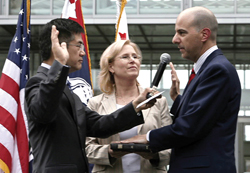
Gary Locke, Leslie Kimball, and David Kappos
Photo: courtesy of USPTO.gov
U.S. Secretary of Commerce Gary Locke, whose department includes the PTO, gave a stark assessment of the trend on Aug. 13, speaking to thousands of employees gathered for Kappos’ swearing-in at the agency’s headquarters in Alexandria, Va.
“This has a direct, negative impact on America’s economic competitiveness, creating uncertainty for entrepreneurs and inventors,” Locke said. “Over time, the PTO has not evolved quickly enough to keep up with America’s changing climate of innovation.”
The average pendency for a patent application is 38 months. Kappos wants that down to 20 months within three years and then, for patents that qualify for a fast track, 12 months.
But he’s tasked with doing the near-impossible on the extreme cheap. The PTO faces a $200 million shortfall in 2010 and began a hiring freeze early in 2009. With attrition, the workforce is shrinking by roughly 40 examiners each month.
BIG TITLE, SMALL BUDGET
His title might vie for longest in the federal government: undersecretary of commerce for intellectual property and director of the United States Patent and Trademark Office. But now charged with calming the seas, Kappos needs an even bigger budget.
The PTO is self-funding through fees paid by those seeking patents and trademarks. But there is a wall between the two budgets; trademarks—having their own problems, though much less troubled—can’t subsidize patents.
When applications and the resulting fee income soared in the 1990s, there wasn’t a wall high enough to keep Congress from taking $752 million from the office from 1992 through 2004. It became an appropriations cookie jar, with legislators grabbing $200 million one year alone.
Now, with applications and fee payments down, the enormity of the funding shortfall “creates a pretty big overhang,” Kappos says. In trying to remake an understaffed agency that has a hiring freeze, “funding is overhanging every decision,” he adds.
Congress mandated a hiring spree in 2005 to pare the backlog. For three years in a row, 1,200 new examiners arrived on the agency’s campus. But that ended abruptly in early 2009.
Locke had asked Congress to impose an emergency 15 percent increase in patent fees to make up for the shortfall. Instead, Congress promised an extra $100 million if the agency could bring in $100 million more than expected. But when a surprising uptick in patent applications made it seem likely that an extra $100 million in patent fees would be generated for 2010, Congress promptly reneged, leaving the agency’s budget unchanged and the general budget as the landing place for any windfall.
Now the agency will be lucky to get back to where it had been. Besides the backlog and poor morale, Kappos has to deal with an antiquated information technology system. Already into the second decade of the 21st century, he says the PTO is still using 20th century technology to handle patent claims by innovators.
Hearing news of his appointment, some at the PTO quipped that they hoped Kappos would bring a few truckloads of equipment along with him from IBM.
CIRCUITOUS ROUTE
Kappos joined Big Blue as a development engineer in 1983. During the late 1980s he took leaves of absence during two school years to attend full time at the University of California at Berkeley’s Boalt Hall. He then worked at IBM’s intellectual property law training center in northern Virginia full time while attending night classes at George Washington University Law School. Boalt Hall accepted those credits for his last year and he received his law degree in 1990.
From there he worked in various stops throughout the corporation: storage division, litigation group, assistant general counsel based in Japan for IBM Asia/Pacific, and corporate counsel.
Over the years he dealt firsthand as a customer with the PTO’s problems; he also worked on them as a board member of the American Intellectual Property Law Association, most recently as its vice president, as well as having been vice president of the Intellectual Property Owners Association.
Kappos came into the job with a mandate to “reboot” the patent office, in the words of Locke. It is more like a complete rebuild, from the agency’s unusual foursquare backing of a legislative reform package to root-and-branch changes in how examiners are graded for performance.
Kappos came in with blessings from all sides in an otherwise severely splintered intellectual property community in which the two biggest players, pharma and high- tech, have been in a virtual Cold War over aspects of reform, whether legislative, judicial or within the patent office itself.
All of this should be enough to keep the IP community’s attention for the foreseeable future. But there could be similar upheaval or change in the courts and legislature in the coming year in what amounts to the possibility of a perfect storm. (See “Congress Takes a Crack” and “Courts Go Back to Basics.”) And yet the possible legislative and judicial changes for the patent system are dwarfed by what has happened and is happening at the patent office.
INVENTING CHAOS
How did things get this way at an agency that itself was created to decide what is unique and effective at doing something? Consider the “invention” that used to be U.S. patent No. 6,368,227.
Granted to a 5-year-old Minnesota boy in 2002, it involved pushing a playground swing from side to side rather than the conventional backward-forward motion. The patent’s approval got headlines around the country and eye-rolling chuckles from millions. The boy’s father was a patent lawyer.
After all the attention, the patent was revoked, but the sideways swing helped set in motion a contraction in the allowance rate, one that is choking tighter and tighter seven years later.
That patent “brought to a head some of the craziness that was going on at the patent office at the time,” says Gene Quinn, a Leesburg, Va.-based patent attorney and author of the IPWatchdog blog. “I point to that swing as significant because so many who have since left the patent office talk about the impact it had.”
After the sideways-swing fiasco, new policies and procedures were implemented for quality control. They had the effect of rewarding examiners more for rejecting patents; leading inventors to continue their claims, which amounts to refiling; and pushing morale so low among examiners one might patent the method that got them that way.
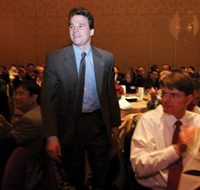
Johnathan Dudas
Photo by AP images
In 2004, then-PTO head Jonathan W. Dudas implemented two significant quality-control measures:
• A recertification program for examiners. Where previously examiners were certified in their positions after passing an exam, they now had to be recertified every three years.
• A “second pair of eyes” initiative launched in 2000 for closer review of business-method patents was extended to all patent applications.
“The levels of review got ridiculous,” says Robert Budens, president of the Patent Office Professional Association, the union representing examiners and other patent professionals in the agency. “The allowance rate began to drop like a stone, in part from a larger fear created in the examining corps, and especially the supervisors who don’t want to get dinged on their performance. People started becoming fearful of allowing things because you could run headlong into quality review problems that make life miserable.”
Dudas and Budens agree that a 2005 decision by the U.S. Court of Appeals for the Federal Circuit threw even more sand into the patent office’s wheels when it curtailed examiners’ ability to reject patents offering solutions that are obvious. The U.S. Supreme Court reversed that decision in 2007 in KSR International Co. v. Teleflex Inc.
Dudas defends his quality-control measures, though he does admit they had some unintended consequences.
“We focused on quality with a number of new initiatives and the error rate came down,” Dudas explains. “We anticipated the allowance rate to come down, but didn’t think it would come down as much as it did. You never target an allowance rate.”
While morale plummeted among examiners, it probably wasn’t that good at the top, either. All the while in the background, from cocktail palaver to prominent blogs, there were questions about the bona fides of political appointees in the PTO leadership, some of whose backgrounds ran deep in politics and shallow on patents.
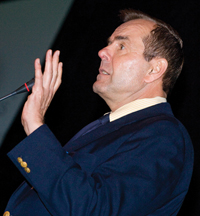
Bruce Lehman
Photo: courtesy of www.iam-magazine.com
In crafting the American Inventor Protection Act of 1999, Congress inserted a proviso calling for the director and other high-level appointees to have “a professional background and experience in patent or trademark law.” The previous year Bruce Lehman had resigned as agency director. Appointed in 1993, he was credited by some with bringing the agency and intellectual property issues from the backwaters to a prominent stage, but Lehman was dogged by the fact that his background was in copyrights.
After his failed efforts to get the U.S. Copyright Office moved from the Library of Congress to the PTO, Lehman ended up leaving in 1998. Q. Todd Dickinson, with an extensive career in patent law, took over for the final two years of the Clinton administration.
In 2001 President George W. Bush appointed James Rogan, who had no experience in patents, trademarks or intellectual property in general. As a congressman, he had been one of 13 U.S. House managers in President Bill Clinton’s impeachment trial, and in the 2000 elections, his Los Angeles County constituency showed their disapproval at the polls. Bush picked him up.
After a little more than two years, Rogan resigned and went into private practice. He now is a California state court judge. He was succeeded by Dudas, who also came from Capitol Hill in 2002 to be the agency’s No. 2 appointee. Dudas had worked on intellectual property matters as a congressional staffer, but otherwise had no background in patent or trademark law.
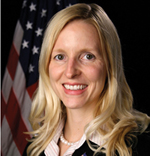
Margaret Peterlin
Photo: courtesy USPTO.gov
In 2007, a San Francisco lawyer and patent activist, Gregory Aharonian, along with several others, sued for the removal of a political appointee in a high-level position at the PTO, saying she was not qualified under the provisions of the 1999 statute. The suit claimed Margaret Peterlin’s only qualification was that she’d served as a senior aide to House Speaker Dennis Hastert, R-Ill., who resigned in late 2007 not long after her appointment.
Judge James Robertson of the U.S. District Court for the District of Columbia dismissed the case in December 2007, finding no congressional intent for a private cause of action. But in his opinion, Robertson wrote that even if he couldn’t order it, it would be good if Peterlin acknowledged her deficiencies and asked various PTO constituencies for help.
“Besides holding out the prospect of actually addressing the real problems besetting the office,” he wrote, “any such behavior from Ms. Peterlin would be a refreshing change from the hostility and adversarial stance taken in recent times by patent office management.”
The point was made. Peterlin resigned eight months later, in August 2008.

James Rogan
Photo: courtesy of Tim Sloan/AFP/Getty images
“If I had known about the law, I’d have sued earlier over Rogan and Dudas,” says Aharonian, whose expertise is in picking apart existing patents through in-depth research into prior art and previous innovations. He also distributes his sometimes gossipy, often strident and usually informative Patnews e-mail to subscribers to the Internet Patent News Service.
• • •
Before Kappos was appointed, president Barack Obama’s transition team was making calls to learn what to do about the PTO. They didn’t ask about legislative reform, which has been on Congress’ platter for several years. They wanted to know how to fix the office as a functioning bureaucracy. One difficulty was to find someone acceptable to the intellectual property community as a whole.
IBM has its own particular wants and needs in an IP community that is diverse and splintered on issues such as damages in litigation and proposals for post-grant review of patents to head off lawsuits.
But Kappos’ arrival was welcomed by all (except the anti-patent crowd, who believe patents stifle innovation). Almost immediately he began a flurry of bold initiatives designed to shore up sagging morale within the agency, soothe the biggest concerns of innovators and reduce the backlog, without having to sacrifice quality.
Barely a couple of weeks into the job, he did the unthinkable—he attempted to change the 30-year-old system of rewards and penalties that decide how patent examiners perform their jobs. Kappos sent an e-mail to all examiners addressing the culture of rejection in which a lower allowance rate became the measure of higher quality. “Let’s be clear: Patent quality does not equal rejection.”
Kappos says he “figuratively” locked the agency’s top managers and union officials in a room for six weeks until they hammered out a new “count system” for how examiners are evaluated in moving patent claims through the process.
At the outset, surprising some and showing seriousness about getting something done, he gave full decision-making authority to the deputy commissioner of patents he sent to the negotiations, Margaret “Peggy” Focarino. She has been at the agency since 1977 and for many years supervised patent examiners and their immediate supervisors.
The resulting changes, putting more emphasis on the initial patent examination and giving less credit for those that are drawn out through re-examination, were announced in early October and will be phased in. They also end the much-hated, labor-intensive recertification program for examiners.
“That was a major accomplishment and a major paradigm shift in how we’ve done business in the past,” says union president Budens. “During the last administration, unions were persona non grata.”
At about the same time, Kappos rescinded widely despised rules proposed by the Bush administration for handling patent applications. Among other things, they would have severely limited attempts at convincing examiners of a claim’s merit in a system that had become weighted in favor of rejections.
Many of Kappos’ early efforts have involved making a clear break with the past, especially the most recent past. When he rescinded the rules, the very first sentence in an agency news release described them as “highly controversial regulations proposed by the previous administration.”
“Those rules went through the Administrative Procedures Act process and got almost 600 negative comments, the biggest response to a rule-change package in the history of the agency,” says Budens. “Virtually all of them were negative and the agency leadership just ignored them.”
As an official with the American Intellectual Property Law Association, Kappos filed an affidavit on behalf of the association’s friend-of-the-court brief supporting a court challenge of the proposed rules. The rules were stopped by federal court injunction, and soon after coming to the PTO, Kappos rescinded the rules package and the case was dropped.
But the union, which has been whipsawed by changes in agency leadership over the past 20 years, still opposes the PTO’s bid for Congress to grant it more substantive rule-making powers—considered unlikely at present.
“What Dave [Kappos] has to do is try to win [union members] back over,” says former PTO head Dickinson, “and the challenge, of course, is that Dave is here today but who will be there tomorrow?”
He is speaking of the union, but it could easily apply to relations with Congress, too.
Kappos is working on it.
Sidebar
Congress Takes a Crack
Legislative proposals for revamping the patent process have been moving along better than they did in recent years. Those in favor of reform are confident something will be passed in the current Congress.
“I didn’t hold much hope for legislative reform this year until the new administration stepped in proactively to indicate its strong support for the bill,” says James Pooley, who, after appointment by President Barack Obama, was slated to leave his partnership at Morrison & Foerster to become deputy director general for patents at the World Intellectual Property Organization in Geneva.
Patent reform failed in 2005 and 2007, primarily because of a battle over the way damages are calculated in litigation. The high-tech industry prefers a surgical method, one that weights the specific loss caused by a particular patented part among many. Pharmaceutical companies see patent protection for each drug as all-or-nothing stakes. They want the possibility of obtaining significant damage awards to help defend patents.
The big compromise in U.S. Senate Bill 515 calls for a “reasonable royalty” with detailed methods for calculating it, and it makes the judge a strong gatekeeper to ensure that juries don’t stray from those methods.
Among other measures, the legislation would grant patents to those first to file an application rather than try to sort out who was first to invent, and it would require trial courts to certify cases by strict standards for interlocutory appeal.
Lobbying is often the true measure of an issue or cluster of issues on Capitol Hill. From 1998 to 2005, corporations and organizations reported between 500 and just under 700 instances of lobbying each year on patent, trademark and copyright issues. (Patents and patent reform are believed to get the lion’s share of attention.)
In 2006 the number of lobbying attempts jumped to 795; then 1,147 in 2007 and 2,349 in 2008, according to the Center for Responsive Politics.
And the money flows. The center’s reports indicate, for example, that the Coalition for Patent Fairness, whose members include the likes of Apple, Dell, Google, Microsoft and Oracle, spent $6.8 million lobbying on patents from 2006 to 2008.
Courts Go Back to Basics
For the first time in 30 years, the U.S. Supreme Court will rule in a case that raises a most basic question: What is patentable? The last time was 1980, in Diamond v. Chakrabarty, a 5-4 decision that involved biotech and whether genetically modified microorganisms could be patented. Writing for the majority, Chief Justice Warren Burger said they could, noting Congress had intended that patents could be issued for “anything under the sun that is made by man.”
That opinion sometimes has left the courts, as well as patent examiners, asking and answering questions that sound like they come from ancient philosophers contemplating the substance of the shadow of smoke.
This court term, Bilski v. Kappos brings scrutiny to a business-method patent.
The notion that you could patent a way of doing things (Bilski concerns a way of hedging risk in commodity trading) accounted for a significant increase in patent applications beginning in the mid-1990s. Innovators began to run with it after the U.S. Court of Appeals for the Federal Circuit ruled in 1998—in State Street Bank v. Signature Financial Group—that a tax-avoidance scheme involving mutual funds was patentable.
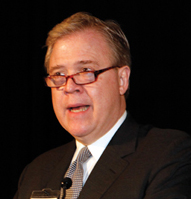
Q. Todd Dickinson
Photo: courtesy www.iam-magazine.com
Now the intellectual property community is anxiously watching as the high court mulls patentability, says Q. Todd Dickinson, executive director of the American Intellectual Property Law Association and former head of the U.S. Patent and Trademark Office.
“The software industry has filed [amicus] briefs saying whatever you do, don’t rule that software is not patentable,” he says. “Ditto from biotech. They’re worried that something in dicta or in the opinion might go outside the narrow scope of the question with unintended consequences.”
‘COMMON’ ISSUES
Some of the problems with patent law were created in the courts through the common law, and some believe the courts should fix them rather
than have the legislature do so. Chief Judge Paul Michel of the Federal Circuit has been calling on lawyers to bring the thorniest cases before the court even when they believe the law is settled.
“Precedent isn’t necessarily permanent and immutable,” Michel says, “and if there is reason to reconsider it, we should do that en banc.”
The judge gets an agreeing nod from Mark Lemley, the Stanford Law School professor who with Dan L. Burk wrote The Patent Crisis and How the Courts Can Solve It. Their key point is that different industries (e.g., pharma and high-tech) innovate differently, and the patent system needs to accommodate that.
“If you look at the patent reform legislation as first introduced in 2005 and where we are now,” Lemley says, “virtually all the difficult, controversial issues being tackled back then concerning litigation abuse of patents have either been solved or seem in the process of being solved by the courts while Congress was thinking about what to do about it.”
He ticks off several examples, such as limiting injunctions to stop abuse by “patent trolls” with no real interest in the patent, changing the standards for obviousness in determining whether a patent is unique, making it easier to challenge patents through declaratory judgments, changing the rules for willful infringement, and making it easier to remove cases from jurisdictions favored by forum shoppers.
“And most recently the Federal Circuit has come out with a strong opinion on damages,” Lemley says. That opinion calls for district court judges to be more diligent gatekeepers, as does a current legislative proposal.
Still, some of those potential litigants Michel is encouraging might feel safer waiting. During the next two years or so, the Federal Circuit is likely to undergo its greatest change since its inception in 1982. Of its 12 judges, several are eligible for senior status, and eight will be so by early 2010. Michel announced in November that he will retire and not take senior status at the end of May.



